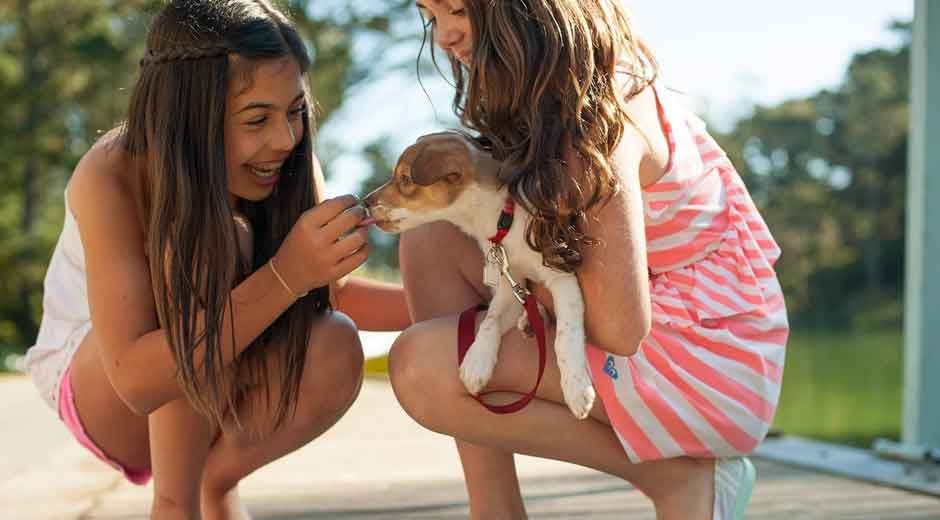Skip to the good bit
TogglePets are a source of entertainment and unconditional love, but they can also provide our young ones with invaluable lessons. Children develop strong bonds with the animals in or around their family as they learn how to interact with a being who can’t use human speech to express their needs and desires.
According to studies, children who grow up with pets have better Emotional Intelligence (EQ) than those who don’t get to interact with animals. A high EQ has been linked with a more successful and fulfilling life, with better connections and opportunities.
So, if you’re on the fence about getting a pet when there are young children roaming around the house, let’s explore the main benefits, especially the ones connected to emotional growth.
What Do Pets Teach Your Children?
Emotions are a tough nut to crack, even for adults. This is why many children struggle to understand basic concepts that are important in today’s society, such as compassion, empathy, and responsibility for your own decisions.
As they get exposed to more social environments, such as kindergarten or school, they’ll learn, but wouldn’t it be nice to give them a head start?
Studies show that children who have at least one pet in the house learn at an early age to be compassionate and care for others. Initially, they imitate their parents, who care for the pet and learn to be gentle and respectful toward another being.
Interactions with a pet from a young age teach children about life outside themselves. Also, as they grow older, they’re more willing to take over some of the tasks that involve the pet (walking, feeding, cleaning, or grooming).
Caring for a pet is also a great way to build self-esteem in children. Even the smallest of tasks that are about someone else (like refilling a dog’s water bowl) can give kids a sense of accomplishment and help them feel independent.
Cognitive Development
Have you ever heard your child read or tell a story to their pet? It happens more often than you think!
But besides the cute factor (which, let’s face it, is through the roof!), this is a form of communication that helps young children develop verbal and cognitive skills.
Pets don’t mind this type of interaction and might even respond by engaging with the child’s attempts to communicate (especially if the pet is a dog or a vocal cat). This encourages the kids to keep going and engage even more.
There is also strong evidence that growing up with pets helps children develop empathy and understand non-verbal language. By simply observing their animal’s behavior, kids get more perceptive on how to interpret intentions based on behavioral cues.
Later in life, these skills will help them become better listeners and communicators, broadening their professional and personal opportunities.
Pets and Mental Health Issues
Even though it may be hard to believe, many children suffer from stress and anxiety. Our tiny humans are easily influenced by their environment (at school, at home, or online) and sometimes feel like the weight of the world sits on their shoulders.
In such cases, kids and teenagers often rely on their non-verbal friends (dogs, cats, rabbits, birds, or even lizards) for emotional support. They feel they can share more with their pets without being judged or lectured.
This is why mental health professionals can prescribe an emotional support animal (or ESA) as a therapeutic option. It’s important to note that ESAs are not regular pets or service animals. They do get special treatment sometimes, but this depends on the emotional support animal laws in your state and only if you have an ESA letter.
ESAs and Social Anxiety
An emotional support animal can be of great help to kids who suffer from social anxiety (mild or acute), and for those grieving a loss, learning how to communicate with a deceased pet can offer additional comfort and healing. Just their presence or being able to stroke their fur can keep a socially anxious person calm in triggering situations.
Additionally, a pet is a social buffer. For instance, if you walk a dog or go out accompanied by a cat, there will be people who want to interact. They may want to say hello, take a picture, or simply play with the pet for a little bit. This creates low-pressure opportunities to connect with other human beings and become more social.
Stress Reduction
Activities that involve a pet, such as grooming, petting, playing, or feeding them, keep the mind firmly grounded in the present. This means that your kid will think less about the future or any big hurdle they may be facing and more about how to keep their favorite animal happy.
Pets also help reduce screen time and increase family interactions.
In Summary
Whether it’s a dog, a cat, a bird, or a turtle, your kid(s) will love the experience of growing up with a pet. Studies show kids with pets are more active, experience better emotional growth, and become better communicators. So, if you’re considering adding a beloved, non-verbal family member, there’s no reason not to!







